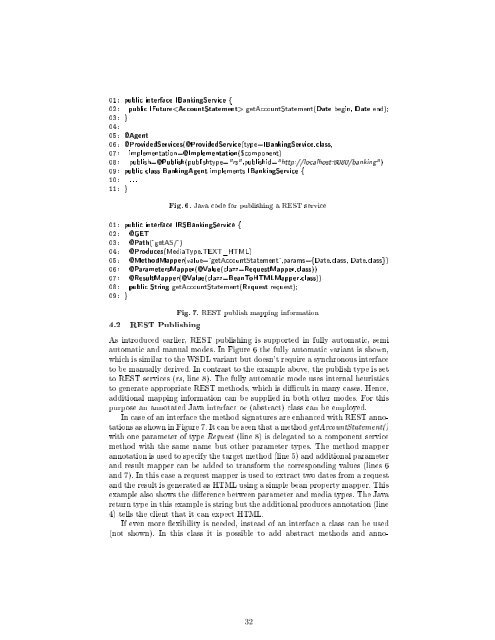Here - Agents Lab - University of Nottingham
Here - Agents Lab - University of Nottingham
Here - Agents Lab - University of Nottingham
You also want an ePaper? Increase the reach of your titles
YUMPU automatically turns print PDFs into web optimized ePapers that Google loves.
01: public interface IBankingService {02: public IFuture getAccountStatement(Date begin, Date end);03: }04:05: @Agent06: @ProvidedServices(@ProvidedService(type=IBankingService.class,07: implementation=@Implementation($component)08: publish=@Publish(publishtype="rs",publishid="http://localhost:8080/banking")09: public class BankingAgent implements IBankingService {10: . . .11: }Fig. 6. Java code for publishing a REST service01: public interface IRSBankingService {02: @GET03: @Path(getAS/)04: @Produces(MediaType.TEXT_HTML)05: @MethodMapper(value=getAccountStatement,params={Date.class, Date.class})06: @ParametersMapper(@Value(clazz=RequestMapper.class))07: @ResultMapper(@Value(clazz=BeanToHTMLMapper.class))08: public String getAccountStatement(Request request);09: }Fig. 7. REST publish mapping information4.2 REST PublishingAs introduced earlier, REST publishing is supported in fully automatic, semiautomatic and manual modes. In Figure 6 the fully automatic variant is shown,which is similar to the WSDL variant but doesn't require a synchronous interfaceto be manually derived. In contrast to the example above, the publish type is setto REST services (rs, line 8). The fully automatic mode uses internal heuristicsto generate appropriate REST methods, which is dicult in many cases. Hence,additional mapping information can be supplied in both other modes. For thispurpose an annotated Java interface or (abstract) class can be employed.In case <strong>of</strong> an interface the method signatures are enhanced with REST annotationsas shown in Figure 7. It can be seen that a method getAccountStatement()with one parameter <strong>of</strong> type Request (line 8) is delegated to a component servicemethod with the same name but other parameter types. The method mapperannotation is used to specify the target method (line 5) and additional parameterand result mapper can be added to transform the corresponding values (lines 6and 7). In this case a request mapper is used to extract two dates from a requestand the result is generated as HTML using a simple bean property mapper. Thisexample also shows the dierence between parameter and media types. The Javareturn type in this example is string but the additional produces annotation (line4) tells the client that it can expect HTML.If even more exibility is needed, instead <strong>of</strong> an interface a class can be used(not shown). In this class it is possible to add abstract methods and anno-32


